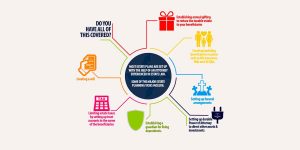Fraud, unfortunately, is a common occurrence in life, whether you want it to be or not. Estate planning can create fraudulent interactions between people you thought you could trust. Building an estate plan requires interacting with other people typically, so fraud can occur but there are measures you can take to ensure you don’t fall prey to people’s desire for wealth. This article examines how fraud can affect the planning of your estate and methods you can take to prevent fraud from occurring, complete with case examples.
Forging Signatures
It can be as simple as catching an unfamiliar signature marring an otherwise flawless will or trust that was supposedly signed by a deceased relative. Suspicions of an invalid signature may plague you and lead to questions of legitimacy. There are a number of factors to consider when attempting to validate a signature – at the most extreme side of things, hiring a forensic document examiner may be the only option. Before spending unnecessary money on a forensic document examiner to officially verify the authenticity of a signature, there are other avenues one may take.
One thing to consider is the age of the person signing the documents – the difference between a forty-year-old’s and a seventy-year-old’s handwriting can be dramatic and almost unrecognizable. Issues related to health, injury and just natural deterioration of motor function due to old age can all cause drastic changes to one’s penmanship. To gain clarity on the consistency of an individual’s handwriting, one should collect at least 15 signatures (preferably more) written by the deceased person within a three-year span of time around the date of the signature in question. It is key that the signatures follow this timeline to accurately assess whether the signature has remained consistent or if there were any changes. Furthermore, if there were any changes, documenting these changes and comparing them to the signature in question can help confirm the signature’s validity.
It is easy to fall under the assumption that collecting only one or two examples of the individual’s signature is sufficient to assess whether there has been any distinguishable change or not but in most cases it simply isn’t enough data to be conclusive. With such a small data set to pull from, it can be nearly impossible to tell if any consistencies were fraudulent or not.
Case Examples
- A forensic document analyst takes on a case where they must determine if a decedent wrote and signed a document that specifies a change in beneficiaries. The analyst was provided with several examples of his handwriting and signatures both from formal and informal documents. They also provided samples of his wife’s and the beneficiary’s handwriting and as they were the primary suspects in the instance of forgery. Based on both handwriting samples, it was determined that the wife has in fact changed the signatures on the “change of beneficiary” forms. Upon reviewing both signatures, it was clear that while there were striking similarities between the testator’s signature and the beneficiary’s, it didn’t match the form of the signature within the few days leading up to the signature on the change of beneficiary form.
Imploring further, the analyst was able to gather that the beneficiary had suffered a stroke a short time before the document was signed and after the stroke, he was rendered incapable of writing his name, particularly in a format/style that matched the new document.
- In another case, signatures were being compared on different amendments to a trust. There was little difference between that of the witnesses and the trustor, but when held against bright light and placed over the top of each other there were slight inconsistencies that pointed towards forgery.
Fraudulent Inducement
In some cases, dependents may attempt to make a claim to fraudulently induce the testator into changing the terms detailed in their estate plan. In cases of fraudulent inducement, the testator is often manipulated into changing their estate plan using fear tactics or blatant lies. In this context, it usually arises when the testator is in a compromised state, such as medically incapacitated. From a legal perspective, for a case of fraudulent inducement to be considered, injury must actually occur in the sense of breach of contract.
Case Examples
- If a benefactor presents false claims and false information about other benefactors in an attempt to yield greater gains over the others and the will is changed to accommodate their desires, this is fraudulent inducement.
- Suppose a benefactor is set to handle the stock portfolio belonging to a father stricken with cancer that doesn’t respond to any conventional treatment. If there was a dramatic increase in stock and the benefactor didn’t disclose the increase to the testator or other family members, a claim of material omission could be made by other family members to yield benefits from the stock’s increased value.



